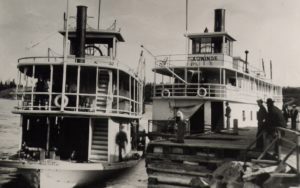Steamer

By the 1890s, the steamboat was the main way for Europeans to access the Rainy River. In fact, the Rainy River first became important to the Dominion Government of Canada precisely because it could be navigated by steamboats. The precursor to Treaty 3 was a right of way agreement permitting Canada to move its troops along the river in order to access Manitoba. By the time of Du Vernet’s tour, the railway had largely replaced the river route, and the steamers largely served settlers living along or moving to the river itself.
The steamboats on the Rainy River were mostly paddlewheel boats. They used a wood-powered combustion engine to turn a stern wheel that worked largely like a paddle or oar, displacing water parallel to the boat to propel it forwards.
These boats were a major source of revenue for the Ojibwe along the Rainy River, both through right of way payments and direct employment. The two main types of paid labour mentioned in contemporary Indian Agent reports are cutting and selling wood to fuel steamers, and salaried work as steamer pilots. Ojibwe people were also passengers on the steamers. Du Vernet writes that Joseph Mcleod travelled “40 miles by steamer from Hungry Hall” to attend one of Du Vernet’s services. This trip cost Mcleod $2 – the equivalent of about $57 today! Impressed by Mcleod’s dedication, Du Vernet paid half of the fare.